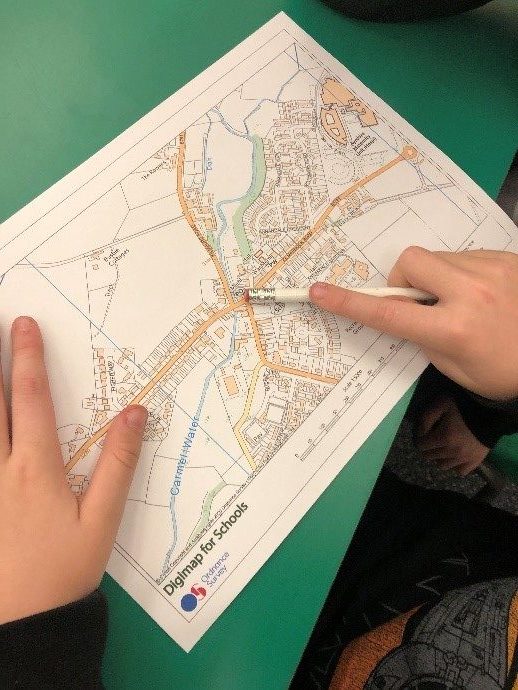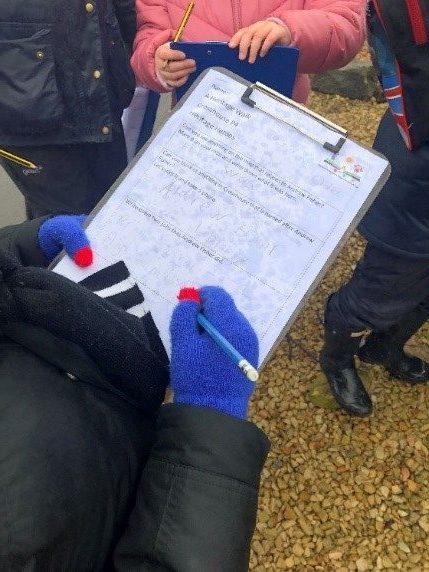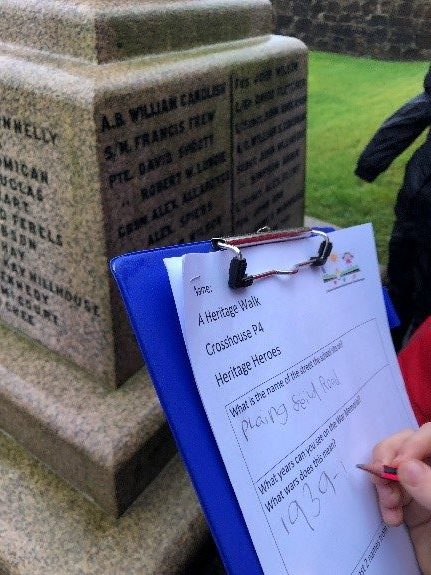
This project was a partnership between Crosshouse Primary School in East Ayrshire and East Ayrshire Council Learning Outdoors Support Team (LOST) as part of the year-long COACh (Curriculum Outdoors Attainment Challenge) programme in session 2019 – 2020. As part of the programme, schools are encouraged and supported to engage in wider achievement awards with pupils working at first level focusing on the Heritage Hero Award. The Heritage Hero Award is a group award which is built around participants discovering and engaging in history and heritage. The award can create links to learning across the curriculum, can take place indoors and/or outdoors and encourages the development of a variety of new skills.
As part of their Heritage Heroes Award, the children in P4/5 at Crosshouse Primary aimed to develop an understanding of some of the key differences found when comparing Crosshouse village in the past to the current village. They planned to focus on the school itself having changed over time and the local roads and buildings surrounding the school. They were keen to involve local villagers to share their memories of school with the children.
Level(s) of award gained: Detective
Size of Group: 26
Age range of group: 7 – 8 years old
Date(s) of project: November 2019 – March 2020
How the project achieved the sections of the award
Plan
The class worked with a teacher from East Ayrshire Council’s Learning Outdoors Support Team (LOST) to plan the award. Initially, they were keen to learn about Crosshouse during World War 2, however they then widened this to discovering about the town history in general.
Using the different stages of the award as inspiration, the pupils worked in groups to think about what they wanted to find out and how they want to do it. They then planned when and how these activities would take place and what they would need to do before they could carry them out (e.g. risk assessments for going outside, inviting villagers into the school to talk). The children then planned how they could share their learning with others both in and out of school.
Investigate
The class began by looking at Google Street Maps of the town of Crosshouse to see what was different even just ten years ago. This helped the pupils to understand the concept of how buildings and landscapes can change over time.
Working with LOST, the pupils accessed and used Digimaps to look at maps of the town from the past and the present day. They looked first at the present day and located landmarks that they knew and recognised including their house, the school, the park and the hospital. They worked together, using what they already knew and discussed what the symbols on the map might mean. Pu pils then compared this map to one from the 1800s and identified what was different and where they thought places that they knew would be, if they were missing.
pils then compared this map to one from the 1800s and identified what was different and where they thought places that they knew would be, if they were missing.
Pupils also used the maps to locate any areas in the town that could be related to Andrew Fisher, who was a prime minister of Australia, but was born in Crosshouse. They worked out that there were some street and building names related to him and that there was a memorial dedicated to him that the class were keen to visit and investigate.
Pupils also looked at black and white photographs and tried to identify where these places were in the town and ex amined how they had changed. They used the maps to locate these places and to work out if they were still there or if they were now different.
amined how they had changed. They used the maps to locate these places and to work out if they were still there or if they were now different.
Pupils also asked people in their families and community for any stories or tales they had of life and times gone by in the town.
Engage
The class were visited by two gentlemen from the town who had lived there for their whole lives. They were able to tell the pupils what the streets looked like, what the school was like and what the shops were when they were children. The pupils then used this information to create a diagram which compared their own life to life in Crosshouse in the past.
With LOST, the class went on heritage trails around the town. They located the War Memorial in the church grounds on the map and then went to visit it. T hey took photographs of it, and used the information on it to answer some questions.
hey took photographs of it, and used the information on it to answer some questions.
They also did some sketches and drawings of the war memorial. They visited the Andrew Fisher Memorial to draw it and used the information engraved on it to answer questions.
Using the black and  white pictures that were looked at before, pupils traced them and then used them to create their own black and white images of Crosshouse using chalk and charcoal, which were displayed in the school corridor.
white pictures that were looked at before, pupils traced them and then used them to create their own black and white images of Crosshouse using chalk and charcoal, which were displayed in the school corridor.
Inspire
Unfortunately due to school closure during the lockdown, the project had to be adapted slightly as the plan had been to create an opportunity for pupils to share their learning with another class. However, the display outside the classroom and the use of floor books did give evidence of sharing their learning with others. To inspire others, the pupils created a display using the images they created and the maps that they had been studying and making notes on. Information was also shared in the class Outdoor Learning floorbook which could be viewed in the school by teachers, other pupils and parents when they visited.
Reflect
Working in small groups allowed the children to have confidence to speak, ask questions and engage in high quality discussion with each other and adults, encouraging them to reflect on what they had learned and what this meant. They then used this information to think about what they would like to find out next or share in their floorbook. Having local villagers in to share their experiences made the learning meaningful for the children, allowing them to consider the differences between life now and life in the past. The children’s skills in communication and research were developed and they showed respect and understanding for members of the community and the local area. They developed their understanding of some local landmarks and reflected on their significance in the village and were able to discuss why certain people were significant to Crosshouse as a village. Looking at maps of the local roads and buildings gave the children an opportunity for cross-curricular links in numeracy and maths and by being out in the local community children were able to ask questions to seek information on local roads.
Lessons Learned
It would have been nice to have an actual sharing event at the end of the project to provide pupils with a real opportunity to share and reflect on what they learned in a meaningful way. It would also have been beneficial to have some more time to spend on the project to really consolidate children’s learning. Due to the coronavirus pandemic and subsequent school closures, this couldn’t happen, unfortunately.
Highlight(s)
A highlight of the project was seeing how the children engaged with the heritage that was around them and that they saw on a daily basis, but had perhaps not really thought about before. They were keen and excited to research and discover. They experienced the wonder of finding out what things used to look or be like and through interviews with residents of the village, were able to find out why. It was exciting to see how enthusiastic the pupils became for finding things out and this was clear through questions they came up with and discussions that they had with each other.
P4/5 Communication Centre Teacher Comment: From my class perspective it was a great opportunity for my children to engage in the local environment, learn about the history of the village and they grew in confidence in working together in meaningful group work. For me as a class teacher I gained practical and easy to adapt to different stages methods of taking learning outdoors to enhance the experiences for children.
The benefit of using the Heritage Hero Awards
The award presented a great opportunity for inclusion for children from the school communication centre to develop their social skills and have meaningful opportunities to work with their mainstream peers. There were many opportunities for the children to engage in quality dialogue, allowing them to share their learning with each other.
Working with members of the village, who came in to speak to the children created and built on community links for the school. Additionally, children were so enthusiastic about the project that they carried out research at home. This engaged parents and carers too in the project, who used a range of tools to support their children’s learning.
Using the award was a great motivator for the pupils as they were the ‘Heritage Heroes’ discovering all that they could about the history of their village. On each visit out into the community, the pupils could take on a different role such as ‘investigators” or “detectives”. This gave their learning a purpose and relevance and a sense of fun! The award meant that pupils had a reason to get ‘hands on’ with heritage in their village and gave them a sense of achievement and success.
Case study compiled by:
Alyson Conquer, COACh Teacher, East Ayrshire Learning Outdoors Support Team
With thanks to:
Susan Rands, Class Teacher, Crosshouse Primary School
Claire Scott, Class Teacher, Crosshouse Primary School
Tina Gaitens, Head Teacher, Crosshouse Primary School
The pupils and staff at Crosshouse Primary School
Rebecca Barclay at Archaeology Scotland







